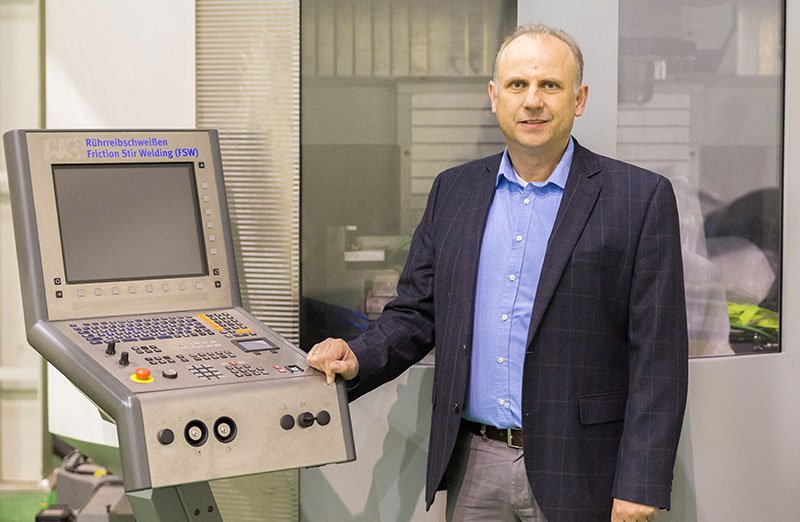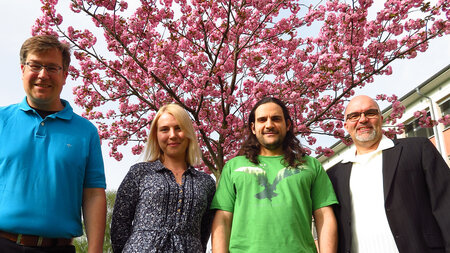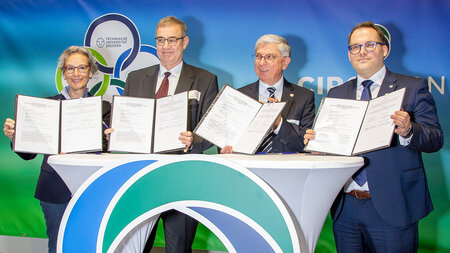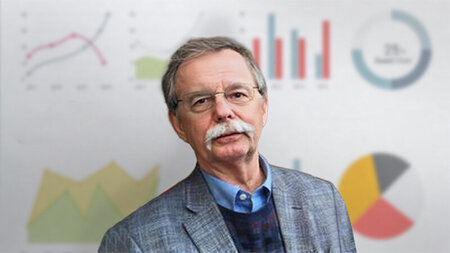Materials Modeled After Nature
Eleven questions for Prof. Dr. Guntram Wagner, Chair of the Professorship of Composite Materials since July 2014
-

In the center of Prof. Dr. Guntram Wagner`s research activities are composite materials and material compounds. He will also be working with friction stir processing, a new and efficient method, which allows to introduce reinforcing particles to work surfaces on a large scale. Foto: Steve Conrad
Since July 2014, Prof. Dr. Guntram Wagner (51) is the Chair of the Professorship of Composite Materials in the Department of Mechanical Engineering. In eleven answers he gives “University News” readers an insight into his professional background, scientific objectives and activities in Chemnitz.
What is actually meant by “composite materials”?
Composite materials usually consist of at least two material components, the matrix and the reinforcing component. The goal is to obtain a manufactured composite material which possesses improved properties compared to the starting components. Nature has demonstrated how well this can work with natural composite materials, such as wood and bone. A well-known and new development in this field is the carbon ceramic brake disc, which has been used virtually exclusively in sports cars until now. The aim of the Professorship of Composite Materials is the development of a cost-effective manufacturing-method of these lightweight, high-performance brake discs for the mass market. The goal is to make the advantages of this innovative composite material more accessible and affordable, even for drivers of compact cars.
The TU Chemnitz is the right choice for me as a professor, because…
…the development of innovative composite materials has a long tradition here. This means an excellent integration in a very successful network in this field even beyond the department’s borders and a very well-established, nationally- and internationally-recognized team at the Professorship of Composite Materials and the Institute of Materials Science and Engineering.
Can you say a few words about your academic career so far?
I chose the TU Kaiserslautern as my place of study, as it offered a young, yet considerably well and modernly equipped department. I completed my studies there, specializing in general mechanical engineering. Afterwards, I completed my doctoral thesis in the field of materials science on the topic of the realization of glass/metal composites via ultrasonic welding. Afterward, new research topics arose. I also worked in areas of fatigue behavior of light metals and composite materials. In addition I also took on the task of the chief engineer, as which I established the Working Field of Joining and Ultrasonic Technology with an internally-recognized research laboratory. A further highlight during my employment at the previous workplace was the development of an ultrasonic fatigue system, which will now also be implemented at the TU Chemnitz. In the summer of 2014, I respond the TU Chemnitz’s call on the Full chair of Composite Materials.
Describe your years of study in only a few words.
Exciting, new ground regionally and scientifically, overcrowding and video-broadcast because of the babyboomers, learning to shift boundaries, best decision.
Did you have role models during your studies who encouraged you to pursue a scientific career?
Alongside an existing impression from my family, my advanced-level physics teacher played a major role in awakening my interest in materials science. He took “his” advanced-level course on a field trip to the renowned institute for metals research in Stuttgart. At this facility copper single crystals were created, which we were allowed to hold in our hands. At first they felt very soft, almost fluid, but after forming they suddenly solidified. I found it to be fascinating at that time, even though I didn’t know which strengthening mechanisms were implemented.
Do you have any advice for young students and graduates?
Students: focus on studying and take enough time for yourself. Think beyond local and scientific borders. Seek out contact to professors and their research assistants, in order to find out which research area is the most interesting to you. Graduates: Don’t forget your university; we could still develop a lot new things together.
What would you like to achieve in your teachings in the future?
During my lectures I have been able to spark a lasting interest in students for materials, composite materials and material compounds. I hope to be able to continue this at the TU Chemnitz as well. At the moment my team and I are involved in creating new forms of instruction, such as online structures, exercises with a practical orientation and expert discussion forums. The leadership of the TU Chemnitz has already agreed to support these activities financially as well.
What impact does your research have at the TU Chemnitz?
Alongside the composite materials I have already described, material compounds will also be central to my research activities. An important field is innovative solder connections, for example with nanoparticles. I will also be working with friction stir processing, a new and efficient method, which allows us to introduce reinforcing particles to work surfaces on a large scale. The existing equipment was transferred to the TU Chemnitz from Kaiserslautern at the end of the last year and will be operational in the next days. The additive manufacturing of composite materials will also be an important research field.
There are around 45,000 professors at German universities. What distinguishes you from all others?
Although composite materials are of great importance in many areas of our life today, there is only a limited number of professors and researchers active in this field.
What is your favorite place to show guests in Chemnitz?
Next to the attractive university, the re-emerging city center with its successful combination of old and new. A visit to the “Nischel”, who happens to be from Rhineland-Palatinate, is also a must.
How do you play a part in the life of the city?
At the moment my activities are focused on the university campus. Beyond that I also like to explore the individual city districts and the area around Chemnitz whenever I have the time. I already know the Wasserschloss Klaffenbach and Schloss Augustburg castles.
More Information on the Professorship (only available in German): https://www.tu-chemnitz.de/mb/lvw/
(Translation: Sarah Wilson)
Katharina Thehos
25.01.2016





